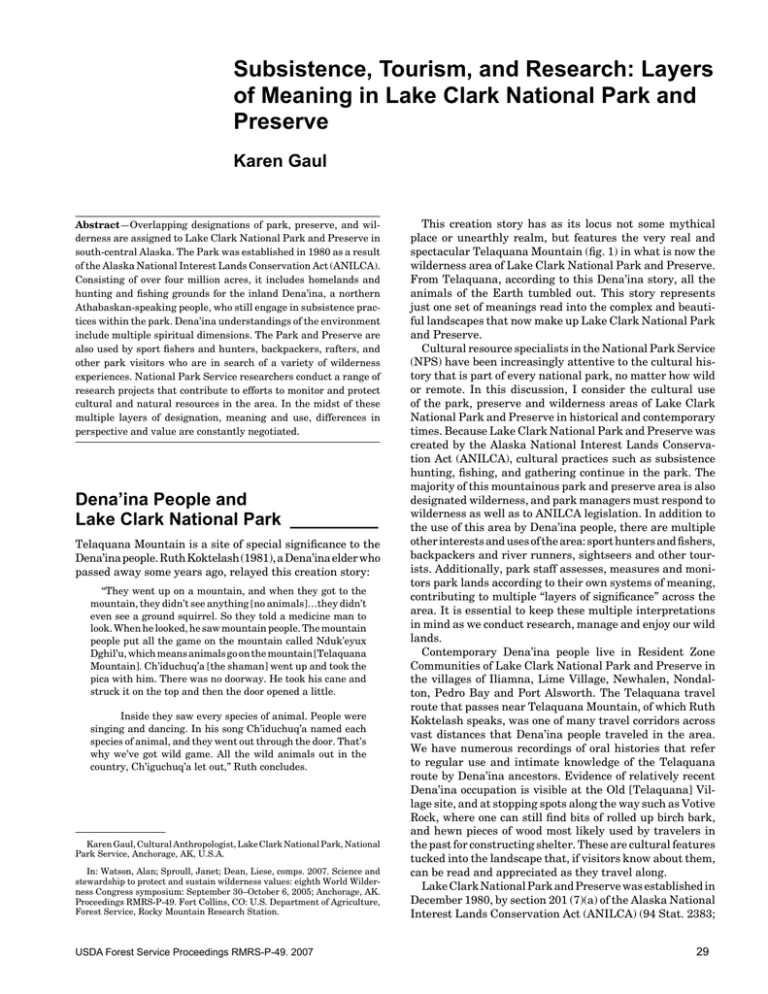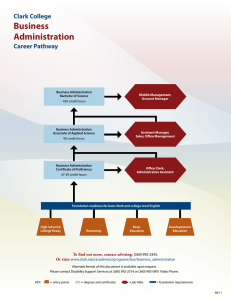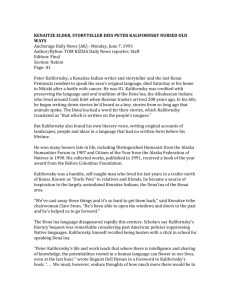Subsistence, Tourism, and Research: Layers Preserve Karen Gaul
advertisement

Subsistence, Tourism, and Research: Layers of Meaning in Lake Clark National Park and Preserve Karen Gaul Abstract—Overlapping designations of park, preserve, and wilderness are assigned to Lake Clark National Park and Preserve in south-central Alaska. The Park was established in 1980 as a result of the Alaska National Interest Lands Conservation Act (ANILCA). Consisting of over four million acres, it includes homelands and hunting and fishing grounds for the inland Dena’ina, a northern Athabaskan-speaking people, who still engage in subsistence practices within the park. Dena’ina understandings of the environment include multiple spiritual dimensions. The Park and Preserve are also used by sport fishers and hunters, backpackers, rafters, and other park visitors who are in search of a variety of wilderness experiences. National Park Service researchers conduct a range of research projects that contribute to efforts to monitor and protect cultural and natural resources in the area. In the midst of these multiple layers of designation, meaning and use, differences in perspective and value are constantly negotiated. Dena’ina People and Lake Clark National Park_ _________ Telaquana Mountain is a site of special significance to the Dena’ina people. Ruth Koktelash (1981), a Dena’ina elder who passed away some years ago, relayed this creation story: “They went up on a mountain, and when they got to the mountain, they didn’t see anything [no animals]…they didn’t even see a ground squirrel. So they told a medicine man to look. When he looked, he saw mountain people. The mountain people put all the game on the mountain called Nduk’eyux Dghil’u, which means animals go on the mountain [Telaquana Mountain]. Ch’iduchuq’a [the shaman] went up and took the pica with him. There was no doorway. He took his cane and struck it on the top and then the door opened a little. Inside they saw every species of animal. People were singing and dancing. In his song Ch’iduchuq’a named each species of animal, and they went out through the door. That’s why we’ve got wild game. All the wild animals out in the country, Ch’iguchuq’a let out,” Ruth concludes. Karen Gaul, Cultural Anthropologist, Lake Clark National Park, National Park Service, Anchorage, AK, U.S.A. In: Watson, Alan; Sproull, Janet; Dean, Liese, comps. 2007. Science and stewardship to protect and sustain wilderness values: eighth World Wilderness Congress symposium: September 30–October 6, 2005; Anchorage, AK. Proceedings RMRS-P-49. Fort Collins, CO: U.S. Department of Agriculture, Forest Service, Rocky Mountain Research Station. USDA Forest Service Proceedings RMRS-P-49. 2007 This creation story has as its locus not some mythical place or unearthly realm, but features the very real and spectacular Telaquana Mountain (fig. 1) in what is now the wilderness area of Lake Clark National Park and Preserve. From Telaquana, according to this Dena’ina story, all the animals of the Earth tumbled out. This story represents just one set of meanings read into the complex and beautiful landscapes that now make up Lake Clark National Park and Preserve. Cultural resource specialists in the National Park Service (NPS) have been increasingly attentive to the cultural history that is part of every national park, no matter how wild or remote. In this discussion, I consider the cultural use of the park, preserve and wilderness areas of Lake Clark National Park and Preserve in historical and contemporary times. Because Lake Clark National Park and Preserve was created by the Alaska National Interest Lands Conservation Act (ANILCA), cultural practices such as subsistence hunting, fishing, and gathering continue in the park. The majority of this mountainous park and preserve area is also designated wilderness, and park managers must respond to wilderness as well as to ANILCA legislation. In addition to the use of this area by Dena’ina people, there are multiple other interests and uses of the area: sport hunters and fishers, backpackers and river runners, sightseers and other tourists. Additionally, park staff assesses, measures and monitors park lands according to their own systems of meaning, contributing to multiple “layers of significance” across the area. It is essential to keep these multiple interpretations in mind as we conduct research, manage and enjoy our wild lands. Contemporary Dena’ina people live in Resident Zone Communities of Lake Clark National Park and Preserve in the villages of Iliamna, Lime Village, Newhalen, Nondalton, Pedro Bay and Port Alsworth. The Telaquana travel route that passes near Telaquana Mountain, of which Ruth Koktelash speaks, was one of many travel corridors across vast distances that Dena’ina people traveled in the area. We have numerous recordings of oral histories that refer to regular use and intimate knowledge of the Telaquana route by Dena’ina ancestors. Evidence of relatively recent Dena’ina occupation is visible at the Old [Telaquana] Village site, and at stopping spots along the way such as Votive Rock, where one can still find bits of rolled up birch bark, and hewn pieces of wood most likely used by travelers in the past for constructing shelter. These are cultural features tucked into the landscape that, if visitors know about them, can be read and appreciated as they travel along. Lake Clark National Park and Preserve was established in December 1980, by section 201 (7)(a) of the Alaska National Interest Lands Conservation Act (ANILCA) (94 Stat. 2383; 29 Gaul Subsistence, Tourism, and Research: Layers of Meaning in Lake Clark National Park and Preserve Figure 1—Telaquana Mountain is a site of special significance to the Dena’ina people (NPS photo). Public Law 96-487). The park (2.6 million acres or 1,052,183 ha) and preserve (1.4 million acres or 566,560 ha) areas, consist of over 4 million acres (1.6 million ha) as of 2001, and of these, close to 2.5 million acres (1,011,714 ha) are designated wilderness. The park area is at the juncture of the Alaskan and Aleutian mountain ranges, which include a dynamic combination of glaciers and active volcanoes. ANILCA’s mandate for Lake Clark National Park and Preserve was the preservation of all of these natural features, as well as sockeye salmon habitat and that of many other wildlife species. The park area also encompasses homelands, and hunting, fishing, and gathering grounds for the inland Dena’ina, a northern Athabascan-speaking people. Prehistoric and historic Dena’ina settlements are found throughout what are now the Park and Preserve, and Yup’ik occupation runs along the southern portion of Lake Iliamna. Numerous archeological sites have been located along lakes, rivers, and coastal areas, and other strategic places. The Dena’ina lived along shorelines for easy fishing access and water transportation routes. They moved with the seasons across the tundra and into the high hills for hunting, trapping, berry picking and other subsistence activities, and covered vast ranges of territory. ANILCA provides for their continued ability to hunt and fish and gather plant resources in Lake Clark National Park and Preserve. We have many oral accounts of Dena’ina people describing their traditional seasonal round. In the spring, they moved to spring fish camps to fish for whitefish and pike, to hunt waterfowl, and to trap muskrats (Ellanna and Balluta 1992); following the break up of the ice, they would move to summer fish camps at strategic locations along rivers, streams and lake edges to catch salmon, which came in species-specific waves throughout the spring and summer. Salmon was and is central to the Dena’ina people’s sense of well being, and their sense of identity. There were countless ways to dry, 30 store and prepare the many parts of the fish (fig. 2). One common way to dry the fish is to split the two large fillets away from the spine of the fish, make lateral cuts in the flesh, and hang it to dry or smoke it. The backs were fed to the dogs, during the period up until recently when people kept dogs for assistance in snow travel for hunting, trapping, packing wood, and other chores. Fish heads were boiled for their oil, fish skins were sewn into storage bags for fish oil or even sewn into boots. Summertime also meant gathering blueberries, cranberries, salmonberries and many others. Families still gather many gallons of different berries, and preserve them in a number of ways. One of the most popular traditional methods was to mix the blueberries with bear fat or other lard, and sugar, to make nivagi or Native “ice cream” (aguduc in Yup’ik) (Johnson and others 1998). People would then prepare for fall hunting, and move to camps up into the lands around their village sites where they might find moose, caribou, black bear, and ground squirrels. Late in October, the Dena’ina fished for spawned out salmon (or redfish), hunted Dall sheep and Brown bears. As the fall turned to winter, snow covered the ground and waterways froze up. Dena’ina would then trap fox, wolverine, mink, lynx and marten, and hunt moose (which have only been available since about the 1940s in the region) and caribou. They would set up winter camps for beaver trapping from January through April. By then, stores of fish for dogs and humans alike, as well as berries and meats may have been running quite low. Early spring fishing was always a welcome turn of the seasons, signaling a move into the flush times of rich summers of plenty of salmon. Oral accounts record intricate details on how this mobile, subsistence lifestyle was maintained. People describe gathering and processing wood and hides to make snowshoes; how to make good spears or the packboard for tying on loads; the making of clothing; and many detailed accounts of how USDA Forest Service Proceedings RMRS-P-49. 2007 Subsistence, Tourism, and Research: Layers of Meaning in Lake Clark National Park and Preserve Gaul Figure 2—Dena’ina people describe their traditional seasonal movements from spring fish camps to summer fish camps. Mary Ann Trefon and daughter Katie with fish and furs (NPS Photo Archives H23). USDA Forest Service Proceedings RMRS-P-49. 2007 31 Gaul Subsistence, Tourism, and Research: Layers of Meaning in Lake Clark National Park and Preserve to catch, process, store, cook and eat fish, moose, berries and many other resources. And they talk of the travel, over lands that were rich with meaning, housed by spiritual beings in various dimensions, and how to live right in such a world. They have offered thousands of names that mark their landscape, guide their routes, and capture events that happened in particular places. Cultural resource managers in the NPS are interested in identifying and documenting such associations people have with what are now park lands. We research and write Ethnographic Overview and Assessments, or baseline documents on the cultural history and use of areas. We identify sacred sites and places of cultural and spiritual significance. We also conduct place-names studies that show the ways cultural meanings are inscribed on the landscape through the very way it was named and talked about. A study documenting Native place-names in Lake Clark National Park and Preserve is currently underway. However, identifying culturally significant meanings inscribed on the landscape can prove a challenging undertaking, especially given the fact that people move, new layers of people move in, and new meanings are applied. We need to consider not simply the traditional use, associations, and meanings of an area, but layers of such associations, and uses. In addition to the Dena’ina and Yup’ik associations to the Lake Clark area, new layers of significance came from Russian promyshlinniki or entrepreneurs, in the fur business, who made their way into these interior areas by the 1790s. These newcomers perhaps read the land as bountiful, rich in resources, and full of opportunity to make good money. It was a place from which to extract resources. The Native Dena’ina participated in fur trade endeavors and served as middlemen, facilitating the extraction and transport of fur animals from interior areas to the trade routes that started in local trade posts on Lake Iliamna (fig. 3), for example, and ended up in far away fashion shops in London or Moscow. Jointly, they recrafted new sets of meanings on the landscape. Similarly, when gold prospectors entered the area, setting up staging camps at the Port Alsworth area for exploration in interior areas, some Dena’ina assisted and participated in gold prospecting as well. Commercial fishing and canning entered the area around the same time as gold prospecting (1890s), and many Dena’ina participated in that—and still do. The commercial approach to fishing was on a scale thousands of times larger than subsistence fishing, but it offered Figure 3—Native Dena’ina people participated in fur trade endeavors and served as middlemen, facilitating the extraction and transport of fur animals from interior areas into the trade routes that started in local trade posts. Pictured here is Wilhelm Neilsen with his furs at Pete Anderson’s house in Old Iliamna, circa 1908–1909 (NPS Photo Archives H1217). 32 USDA Forest Service Proceedings RMRS-P-49. 2007 Subsistence, Tourism, and Research: Layers of Meaning in Lake Clark National Park and Preserve local people an opportunity to earn cash and to participate in a cash economy. Through these early interactions, Dena’ina people and some of the Russian and American newcomers married, had children and built family and community, merging cultural backgrounds, lifeways, and sets of understandings of place. As trappers, traders, prospectors, and explorers moved into the area, new languages and new names were assigned over the top of Dena’ina names. Lake Clark, for example, was previously called Qizhjeh Vena in the Dena’ina language, meaning “a place where people gathered.” John W. Clark was a member of an exploration party in January of 1891, a group of explorers who traveled to the upper tributaries of the Nushagak River. They followed the Nushagak River to the Mulchatna River, and then followed the Chulitna to where it drained into a long lake. They named it in honor of John W. Clark, and the name has been mapped and called Lake Clark ever since. Other Meanings of Lake Clark National Park_ _________ Alaska—or the rights to it—was purchased by the United States from Russia in 1867. Then followed many years of treaties and legislation that imposed new layers of meaning (and new rules about basic rights to lands). Alaska became a State in 1959. After many years of debate, 1971 brought the Alaska Native Claims Settlement Act (ANCSA), which extinguished aboriginal title to 365 million acres (147.7 million ha) of land, conveyed 45 million acres (18.2 million ha) to Native corporations, and paid out $962.5 million to Native corporations (Case and Voluck 2002). A decade later, ANILCA (The Alaska National Interest Lands Conservation Act of 1980) identified new Federal lands including national parks and preserves. Lake Clark National Park, as mentioned, is one such new “ANILCA” parks. ANILCA also helped to designate Native allotments, and village and regional corporation lands. Even now, many lands remain unconveyed, so that the land status map around Lake Clark looks like a colorful patchwork. We can view the inscription of the National Park and Preserve designation, and its wilderness designation, as yet more layers of meaning assigned to this area. Even though the ANILCA parks provide for recognition of resident zone peoples, and their continued subsistence, they also embody something of the identity of other big, western parks. That is, they extend the sense of the wild, wilderness, isolation, ruggedness, and a promise of solitude. Indeed, these are the very things that many visitors come to Lake Clark to seek out. One key assumption underlying the national park idea in general, and the big western nature parks in particular, and particularly wilderness, is that nature is something fundamentally different and separate from human culture. Another is that nature started out pure, devoid of human influences, and it should be protected as such, returned to its pristine state. Nature, and nature parks, can serve as a sanctuary for us to enter into as a refuge from hectic urban life. Braun (2002: ix) describes this externalizing of nature in mainstream American thought, noting that nature is seen as: “a place to which one goes—the site of “resources,” USDA Forest Service Proceedings RMRS-P-49. 2007 Gaul a stage for “recreation,” a source for “spiritual renewal,” and a scene for “aesthetic reflection.” And, we might add, a laboratory for research. Indeed, these are the many reasons visitors come to Lake Clark: for river running, backpacking, camping, sport hunting, and so on. Because it is thought about in a number of ways and serves a variety of purposes for those who visit it, Braun (2002: 10) suggests that nature is always inherently social, and calls it “social nature” (see also Cronon 1995). Research is another set of meanings inscribed on or read from the landscape. Assessing plant and wildlife diversity and numbers is an activity that land managers deem important for resource management. The NPS, with its identification, inventorying and monitoring of natural and cultural resources, and its presentation of these resources to the public, promulgates its own sets of landscape meanings. But these landscape meanings are also multiple, as “wilderness” folks debate with “cultural resource” folks over issues such as what kinds of equipment archeologists can use to do their jobs within wilderness, or what forms of transportation are acceptable in wilderness. Such disputes wage at the agency level, even as subsistence users bristle and grumble about catch and release fishing, and sport hunters who are only after the trophy antlers. We can easily see, even in this brief sketch, that layers of significance for this particular area are not of the same shape, size and weight. The scale and reach are different. What Dena’ina subsistence users claim as their hunting and gathering grounds, and the reasons they claim it, lie pretty close to home. They are fairly local. Larger international claims or attachments of meaning such as those of Russian fur traders mean that the stretch of significance reaches pretty far. When a country like the United States purchases the rights to the whole region of Alaska, sets of national claims and laws are assumed to apply to these lands. And when an area is set aside as a national park, it is defined as land belonging to the American public. Our lands. Our national heritage. Local interests are accommodated—and indeed, subsistence needs are given [nominally] a preference over commercial and sport hunting and fishing—but ultimately are subsumed under the goals and jurisdiction of a national entity. Native experience is codified into mandated management. People’s lives, their history, their places now become the material of cultural resource management. Thus, multiple layers of meaning are held onto, and multiple experiences pursued, simultaneously. Certain definitions of or discourses about environments, or certain landscape ideas, take precedence over others. Thus, even for areas designated Park, Preserve or Wilderness, there are political battles that necessarily link them to cultural agendas. Conclusions_____________________ As park managers, or stewards, we must acknowledge these multiple and changing layers of significance. Wilderness is not unknown territory, but homeland well-known by people who have lived on it and traversed it, using countless plants, animals, water and mineral resources for millennia. Subsistence practices—even as they have radically changed—represent a strong strand of continuity of 33 Gaul Subsistence, Tourism, and Research: Layers of Meaning in Lake Clark National Park and Preserve connection Dena’ina have with the land (fig. 4). These ties are celebrated and strengthened as Dena’ina people themselves reinterpret their past and their traditions, and reinvigorate their language and culture through strong revitalization efforts. In June of this year, I set off with our park historian, John Branson, and Samson Ferreira of the NPS Cultural Landscapes program, to walk the upper part of the Telaquana Trail near the mountain from which all of the world’s animals are said to have emerged. We were there to photo document and record GIS data about cultural sites along the Telaquana travel corridor, which connected people from the Telaquana Lake area to the Kijik area. I loved being out on the Telaquana plateau, slogging through the brush and boggy tundra and enjoying its hugeness. I’m from Montana, but Montana’s “Big Sky” seemed diminished compared to that over the wildness of Lake Clark National Park and Preserve. But what made the trip so rich for me was imagining Dena’ina women of 200 years ago packing their kids on their backs, or hunters with dogs cooking fresh caribou over campfires, building tent shelters from birch bark; or looking up at Telaquana Mountain and thinking of the shaman who tapped the mountain with his cane, and so many other ways Dena’ina and others interacted symbolically and materially with their environment. This is now “wilderness.” But this rich cultural history should not disappear with new layers and designations of meaning, or with new names given to features on the landscape. ANILCA, even as we struggle to apply and interpret it 25 years later, recognized and kept central those cultural connections. In the ANILCA parks, wilderness was and must remain a peopled landscape. References _____________________ Figure 4—ANILCA recognizes and keeps central the cultural connections of people with the landscape in Alaska (photo by Dan Young, Lake Clark NP&P). 34 Braun, Bruce. 2002. The intemperate rainforest: nature, culture and power on Canada’s west coast. Minneapolis: University of Minnesota Press. 347 p. Case, David; Voluck, David. 2002. Alaska Natives and American laws. Fairbanks: University of Alaska Press. 515 p. Cronon, William. 1995. The trouble with wilderness: or, getting back to the wrong nature. In: Cronon, William, ed. Uncommon ground: toward reinventing nature. New York: Norton: 69-90. Ellanna, Linda; Balluta, Andrew. 1992. Nuvendaltin Quht’ana: the People of Nondalton. Washington, DC: Smithsonian Institution Press. 354 p. Johnson, Darryll; Hunn, Eugene; Russell, Priscilla; Vande Kamp, Mark; Searles, Edmund. 1998. Subsistence uses of vegetal resources in and around Lake Clark National Park and Preserve. Technical Report NPS/CCWSOUW/NRTR-98-16. Seattle, WA: U.S. Department of the Interior, National Park Service. 568 p. Koktelash, Ruth. 1981. Oral history recording with Priscilla Russell Kari. Tape 71(1), oral history collections at Lake Clark National Park and Preserve, Anchorage, Alaska. USDA Forest Service Proceedings RMRS-P-49. 2007



